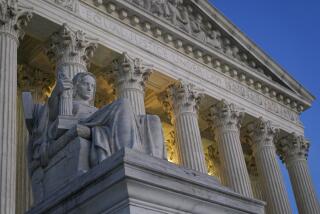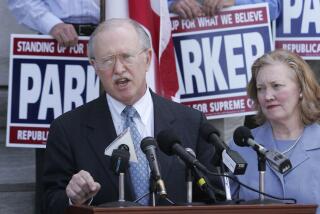‘Right-to-Die’ Ruling Stands
The U.S. Supreme Court refused to get involved Monday in the case of Terri Schiavo, clearing the way for the husband of the severely brain-damaged Florida woman to have her feeding tube unhooked by a state court order.
Barring an unlikely change of heart by Florida judges, Schiavo, now 41, could die soon in a nursing home -- nearly 15 years after she lapsed into a vegetative state.
“It’s judicial homicide. They want to murder her,” Robert Schindler, Schiavo’s father, told reporters Monday. “I have no idea what the next step will be. We are going to fight for her as much as we can fight for her. She deserves a chance.”
The justices dismissed without comment Florida Gov. Jeb Bush’s claim that he had the power and responsibility to keep Schiavo alive after a state judge authorized removal of the tube through which she received food and water.
The governor was appealing a September decision by Florida’s Supreme Court that found “Terri’s Law” -- a measure passed by the state Legislature that gave Bush the one-time power to order the tube reinstated -- violated the separation of powers.
“The effect of this decision is that Terri Schiavo will die of starvation and dehydration as the result of a judicial death warrant,” said Ken Connor, who served as Bush’s counsel in the case. Courts have done more to protect the rights of convicted murderers than a helpless woman like Schiavo, Connor said.
But other attorneys involved with what has become one of America’s most celebrated right-to-die cases said it was too early to say that the protracted legal battles surrounding Schiavo were over.
George Felos, the lawyer for Schiavo’s husband, Michael, said he had no idea when Florida judges would halt “the merry-go-round of litigation” generated by the woman’s parents.
David C. Gibbs III, lead counsel for Robert and Mary Schindler, said Monday evening that he would be moving on three fronts in state courts to try to keep Terri Schiavo alive. On Friday, Gibbs said, he will assert that her right to due process has been violated because she never had a lawyer to represent her and never was brought into a courtroom.
“In my opinion, this case is going to continue forward for at least a few more months, if not for a few more years,” Gibbs said.
Terri Schiavo is being cared for at a hospice in Pinellas County on Florida’s Gulf Coast, and her condition is stable, Felos said. Her husband and the Schindlers once were friendly, but no longer talk because of deep disagreements over how to care for her and what she would have wanted.
In 1998 -- eight years after Terri Schiavo went into cardiac arrest, temporarily cutting off the oxygen to her brain and causing widespread damage to the cerebral cortex -- her husband, a nurse, successfully petitioned a Florida court to have her food and water tubes removed. He said she had told him that she never wanted to be kept alive artificially.
Her parents opposed, pointing out that their daughter could breathe on her own and was not terminally ill.
They also have said Michael Schiavo cannot be trusted to act in his wife’s best interest. Since Terri Schiavo has been incapacitated, Michael Schiavo has had two children with another woman.
Michael Schiavo has had his wife’s tube removed twice, but it was reinserted on a judge’s order in 2001 and on the governor’s two years later. A state judge’s order authorizing its removal has been stayed until the lawsuits brought by Terri Schiavo’s parents are resolved.
Saving Schiavo is a cause that has been embraced by many conservative Christian groups. To some, the former insurance clerk has come to epitomize the overeagerness of judges and care providers to curtail medical care, especially when it is costly.
“The Schiavo case is important because, if Terri’s death sentence is carried out, others similarly disabled will be in danger,” said Dana Cody, attorney and executive director of the Life Legal Defense Foundation of Napa, Calif.
The U.S. Supreme Court’s refusal to intervene came on the same day as thousands of antiabortion protesters marched in Washington. In comments to the marchers, President Bush -- brother of Florida’s governor -- echoed the theme raised in Jeb Bush’s legal appeal.
“The essence of civilization is this: The strong have a duty to protect the weak,” the president said by telephone from Camp David, Md. “We know that in a culture that does not protect the most dependent, the handicapped, the elderly, the unloved, or simply inconvenient become increasingly vulnerable.”
But the Schiavo case did not come to the high court as a test of the new “right to life” or the “right to die.” Instead, the legal dispute turned on the respective powers of courts and lawmakers. The Florida Supreme Court, in its ruling last autumn, told lawmakers they could not “nullify” a court’s final judgment. In his appeal, Gov. Bush’s lawyers argued that he had a right to protect a “class of vulnerable individuals.”
It takes the votes of four justices to hear an appeal, and the U.S. Supreme Court dismissed the case of Bush vs. Michael Schiavo without a comment or dissent.
Despite the lengthy court proceedings spawned by the case, Gibbs said he believed Florida judges would be in no hurry to resolve it.
“If we starve Terri Schiavo to death, and we look back someday and say, ‘We made a mistake,’ there is no turning back,” Gibbs said.
Dahlburg reported from Miami, Savage from Washington.
*
(BEGIN TEXT OF INFOBOX)
Key dates in the Schiavo case
Feb. 25, 1990: Terri Schiavo collapses in her home. Doctors think a potassium imbalance caused her heart to stop temporarily, cutting off oxygen to her brain.
July 29, 1993: Bob and Mary Schindler, Terri’s parents, file a petition to have husband Michael Schiavo removed as Terri’s guardian. The case is dismissed.
May 1998: Michael Schiavo files petition to remove Terri Schiavo’s feeding tube.
Feb. 11, 2000: Circuit Judge George W. Greer rules feeding tube can be removed.
April 24, 2001: Feeding tube is removed from Terri Schiavo.
April 26, 2001: Circuit Judge Frank Quesada orders doctors to reinsert feeding tube.
Nov. 22, 2002: Greer rules there is no evidence that Terri Schiavo might recover and orders removal of tube.
June 6, 2003: 2nd District Court of Appeals upholds Greer’s ruling.
Oct. 7, 2003: Gov. Jeb Bush files a federal court brief urging Terri Schiavo be kept alive.
Oct. 10, 2003: U.S. District Judge Richard Lazzara rules he does not have jurisdiction to intervene.
Oct. 15, 2003: Doctors remove feeding tube.
Oct. 21, 2003: Florida lawmakers pass a bill, “Terri’s Law,” allowing the governor to intervene. He orders the tube reinserted.
May 6, 2004: Circuit Judge W. Douglas Baird rules “Terri’s Law” is unconstitutional.
Sept. 23: Florida Supreme Court strikes down “Terri’s Law” as unconstitutional.
Monday: U.S. Supreme Court rejects governor’s appeal that “Terri’s Law” violated the separation of powers.
Source: Sun-Sentinel
Los Angeles Times
More to Read
Start your day right
Sign up for Essential California for news, features and recommendations from the L.A. Times and beyond in your inbox six days a week.
You may occasionally receive promotional content from the Los Angeles Times.







